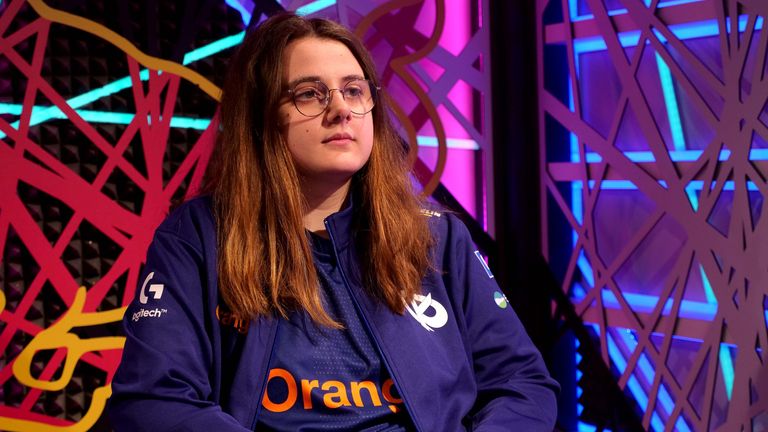The female gamers competing for thousands of pounds at first event of its kind in UK | Science & Tech News
The UK’s first professional women’s gaming tournament of its kind starts on Saturday.
Four teams of professional gamers will play the first-person shooter game Valorant, which is the most-watched esports game in women’s leagues.
It is the first time Europe’s best teams have battled it out in the UK, and organisers hope it will bring more women into gaming.
“The more people see you can enjoy gaming as somebody who’s not native to it, the more confident they’ll get and the more they’ll enjoy it,” said host and streamer Meg ‘Megsoundslikeegg’ Gardner.
The players are competing over two days at London‘s Red Bull Gaming Sphere for a prize pool of £15,000.
Michaela ‘mimi’ Lintrup, who is the one of world’s best Valorant players and has been professionally gaming since she was 18, said: “Back then it was not a big thing like it is today.”
The 26-year-old Dane added: “We fought for a case of Red Bull or something, it was not a prize pool with money. I just played because I had passion for it and I loved it.”
But that’s all changed.
Last year, fans watched more than 28 million hours of professional women’s esports, according to industry tracker Esports Charts. The competitions are usually streamed on places like Twitch, TikTok and YouTube.
Those figures don’t even include people watching in China, where esports are so big that more people watched them than traditional sports at the 2023 Asian Games.
In esports, where people play competitively in a variety of video games, there are leagues, prizes and hordes of fans just like in other sports.
French player Mathilde ‘Nelo’ Beltoise, who is in a team called Karmine Corp, said the level of fandom in France is off the scale.
“Karmine Corp is so huge that everywhere you go, someone will recognise you. Every time I go into the street, I see someone with the jersey. It’s really huge,” she said.
The popularity of her team in France helped Beltoise’s parents, who are teachers, warm to the idea of her playing video games for a living.
“Sometimes one of their students has a Karmine Corp jersey on and they’re like, ‘Is that you?’ Now they just love it,” she explained.
Read more from Sky News:
Why are thousands of video game workers losing their jobs?
New game inspired by House Of The Dragon actor’s grief of losing his father
BAFTA Games Awards: Baldur’s Gate 3 is the big winner, scooping five prizes
Being a professional gamer means glamorous-sounding international travel and online streaming, but it is also a regular nine to five job.
“We practice from Monday to Friday but when we get close to tournament time, we will add Sundays,” said Lintrup.
“We have four games a day which usually last for 50 minutes. Then we can talk a little bit about the mistakes we made [for 10 minutes before the next one]. Then we have about one and a half hours of theory time.”
Lintrup is the in-game leader of G2 Gozen and her role is fairly similar to that of a football captain.
She said: “After practice, I will usually stream or review which means I will go back and watch our games and point out the mistakes. I have to put in a bit of extra work. I love it like that.”
British competitor Sarah ‘sarah’ Ahmed is 18 years old and from Derby. She has been playing professionally for six months and became interested in gaming because of her brother.
She said: “He had a laptop and I didn’t so when I was 16, I got my first PC, and that’s when I started playing games, just like my brother.”
Now, she is travelling the world, having recently competed in Turkey in the first-ever mixed-gender tournament. She described the moment she discovered the women’s gaming scene on Valorant.
“When I was younger, none of my friends played video games so whenever I played, it was just by myself, it was hard making girl friends.
“So when I saw there was a big community with a lot of girls just playing, I wanted to be a part of it.”
Valorant was released during one of the COVID lockdowns, when there was a surge in the number of people playing video games. Host Meg Gardner thinks it is more popular with women because of its storytelling.
She said: “Valorant is very good at being inclusive so you’ll see a lot of female characters that aren’t just in a supportive role, but like people that are very strong in the game. People want to pick them to play with.”
The Red Bull Instalock tournament is being streamed live on Twitch from 12pm UK time on Saturday and Sunday.

















